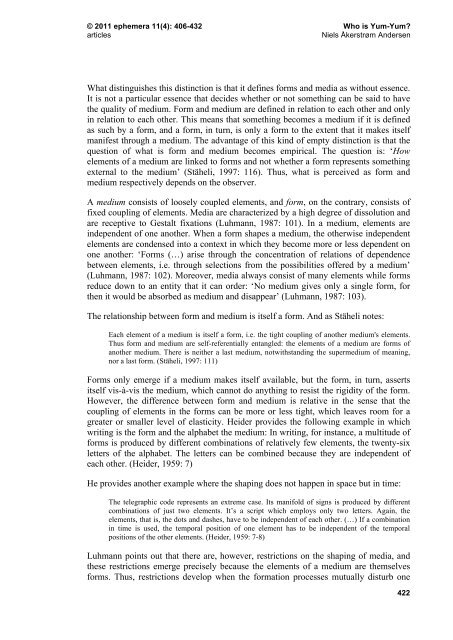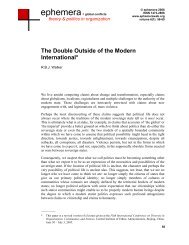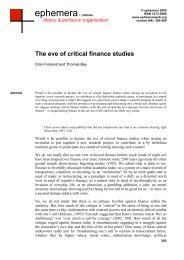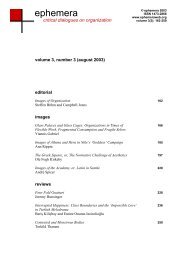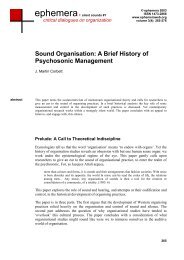Work, play and boredom - Ephemera
Work, play and boredom - Ephemera
Work, play and boredom - Ephemera
Create successful ePaper yourself
Turn your PDF publications into a flip-book with our unique Google optimized e-Paper software.
© 2011 ephemera 11(4): 406-432 Who is Yum-Yum?<br />
articles Niels Åkerstrøm Andersen<br />
What distinguishes this distinction is that it defines forms <strong>and</strong> media as without essence.<br />
It is not a particular essence that decides whether or not something can be said to have<br />
the quality of medium. Form <strong>and</strong> medium are defined in relation to each other <strong>and</strong> only<br />
in relation to each other. This means that something becomes a medium if it is defined<br />
as such by a form, <strong>and</strong> a form, in turn, is only a form to the extent that it makes itself<br />
manifest through a medium. The advantage of this kind of empty distinction is that the<br />
question of what is form <strong>and</strong> medium becomes empirical. The question is: ‘How<br />
elements of a medium are linked to forms <strong>and</strong> not whether a form represents something<br />
external to the medium’ (Stäheli, 1997: 116). Thus, what is perceived as form <strong>and</strong><br />
medium respectively depends on the observer.<br />
A medium consists of loosely coupled elements, <strong>and</strong> form, on the contrary, consists of<br />
fixed coupling of elements. Media are characterized by a high degree of dissolution <strong>and</strong><br />
are receptive to Gestalt fixations (Luhmann, 1987: 101). In a medium, elements are<br />
independent of one another. When a form shapes a medium, the otherwise independent<br />
elements are condensed into a context in which they become more or less dependent on<br />
one another: ‘Forms (…) arise through the concentration of relations of dependence<br />
between elements, i.e. through selections from the possibilities offered by a medium’<br />
(Luhmann, 1987: 102). Moreover, media always consist of many elements while forms<br />
reduce down to an entity that it can order: ‘No medium gives only a single form, for<br />
then it would be absorbed as medium <strong>and</strong> disappear’ (Luhmann, 1987: 103).<br />
The relationship between form <strong>and</strong> medium is itself a form. And as Stäheli notes:<br />
Each element of a medium is itself a form, i.e. the tight coupling of another medium's elements.<br />
Thus form <strong>and</strong> medium are self-referentially entangled: the elements of a medium are forms of<br />
another medium. There is neither a last medium, notwithst<strong>and</strong>ing the supermedium of meaning,<br />
nor a last form. (Stäheli, 1997: 111)<br />
Forms only emerge if a medium makes itself available, but the form, in turn, asserts<br />
itself vis-à-vis the medium, which cannot do anything to resist the rigidity of the form.<br />
However, the difference between form <strong>and</strong> medium is relative in the sense that the<br />
coupling of elements in the forms can be more or less tight, which leaves room for a<br />
greater or smaller level of elasticity. Heider provides the following example in which<br />
writing is the form <strong>and</strong> the alphabet the medium: In writing, for instance, a multitude of<br />
forms is produced by different combinations of relatively few elements, the twenty-six<br />
letters of the alphabet. The letters can be combined because they are independent of<br />
each other. (Heider, 1959: 7)<br />
He provides another example where the shaping does not happen in space but in time:<br />
The telegraphic code represents an extreme case. Its manifold of signs is produced by different<br />
combinations of just two elements. It’s a script which employs only two letters. Again, the<br />
elements, that is, the dots <strong>and</strong> dashes, have to be independent of each other. (…) If a combination<br />
in time is used, the temporal position of one element has to be independent of the temporal<br />
positions of the other elements. (Heider, 1959: 7-8)<br />
Luhmann points out that there are, however, restrictions on the shaping of media, <strong>and</strong><br />
these restrictions emerge precisely because the elements of a medium are themselves<br />
forms. Thus, restrictions develop when the formation processes mutually disturb one<br />
422


